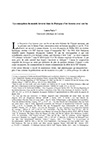Laura Parys
« La conception du monde inversĂ© dans le Dialogue d’un homme avec son ba »
ENiM 13, 2020, p. 217-235.
 Dans cet article, L. Parys propose une analyse du Dialogue d’un homme avec son ba, centrée sur les notions de vie et de mort, sur terre et dans l’au-delà . L’objectif est de justifier la conception du monde que l’homme et son ba développent respectivement, en y relevant les références aux concepts opposés de maât et d’isfet. Un intérêt particulier est accordé aux passages qui associent maât à la mort et isfet à la vie, car il s’agit d’une considération inhabituelle dans la pensée égyptienne, qui renvoie au topos du monde inversé. Au terme de l’analyse, de nouvelles hypothèses d’interprétation du texte sont proposées pour justifier notamment le choix du ba comme interlocuteur de l’homme.
Dans cet article, L. Parys propose une analyse du Dialogue d’un homme avec son ba, centrée sur les notions de vie et de mort, sur terre et dans l’au-delà . L’objectif est de justifier la conception du monde que l’homme et son ba développent respectivement, en y relevant les références aux concepts opposés de maât et d’isfet. Un intérêt particulier est accordé aux passages qui associent maât à la mort et isfet à la vie, car il s’agit d’une considération inhabituelle dans la pensée égyptienne, qui renvoie au topos du monde inversé. Au terme de l’analyse, de nouvelles hypothèses d’interprétation du texte sont proposées pour justifier notamment le choix du ba comme interlocuteur de l’homme.
 In this article, L. Parys presents an analysis of Dialogue of a Man with his Ba, focused on the notions of life and death, on earth and in the afterlife. The aim is to justify the view of the world that the man and his ba develop respectively, by underlining the references to the opposite concepts of maât and isfet. A particular interest is given to the passages which associate maât with death and isfet with life because it is an unusual consideration in Egyptian thought, in connection with the topos of the inverted world. At the end of the analysis, new hypotheses for the interpretation of the text are proposed, in particular to justify the choice of the ba as the man’s interlocutor.
In this article, L. Parys presents an analysis of Dialogue of a Man with his Ba, focused on the notions of life and death, on earth and in the afterlife. The aim is to justify the view of the world that the man and his ba develop respectively, by underlining the references to the opposite concepts of maât and isfet. A particular interest is given to the passages which associate maât with death and isfet with life because it is an unusual consideration in Egyptian thought, in connection with the topos of the inverted world. At the end of the analysis, new hypotheses for the interpretation of the text are proposed, in particular to justify the choice of the ba as the man’s interlocutor.
 Consulter cet article (44771) -
Consulter cet article (44771) -  Télécharger cet article au format pdf (21261)
Télécharger cet article au format pdf (21261)
ENiM 18 - 2025
6 article(s) - 1 septembre 2025.
ENiM 1 à 18 (2008-2025) : 225 articles
4 965 426 téléchargements
9 971 637 consulations.
Index des auteurs

Mots clés

Derniers articles : 
Robert Steven Bianchi
Duplication and Continuity
(ENiM 18, p. 13-36 — 11 mars 2025) 
CENiM - Mise en ligne des volumes Ă©puisĂ©s : 
 Anne-Sophie von BOMHARD DĂ©cans Ă©gyptiens, CENiM 23, Montpellier, 2020 — (2020)
Anne-Sophie von BOMHARD DĂ©cans Ă©gyptiens, CENiM 23, Montpellier, 2020 — (2020) 
 Jean-Claude Grenier L'Osiris ANTINOOS, CENiM 1, Montpellier, 2008 — (26 dĂ©cembre 2008)
Jean-Claude Grenier L'Osiris ANTINOOS, CENiM 1, Montpellier, 2008 — (26 dĂ©cembre 2008) 
TDENiM - Mise en ligne des volumes Ă©puisĂ©s : 
 Twitter
Twitter 3999502 visites - 7696 visite(s) aujourd’hui - 184 connecté(s)
© ENiM - Une revue d’égyptologie sur internet
Équipe Égypte Nilotique et Méditerranéenne - UMR 5140 - « Archéologie des Sociétés Méditerranéennes » (Cnrs) - Université Paul Valéry - Montpellier III






















 Contact
Contact
 Abonnez-vous !
Abonnez-vous ! Équipe Égypte Nilotique et Méditerranéenne
Équipe Égypte Nilotique et Méditerranéenne UMR 5140 « Archéologie des Sociétés Méditerranéennes » (Cnrs)
UMR 5140 « Archéologie des Sociétés Méditerranéennes » (Cnrs) Université Paul Valéry - Montpellier III
Université Paul Valéry - Montpellier III